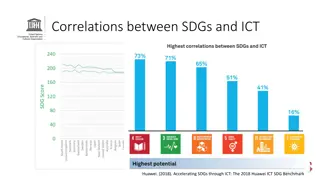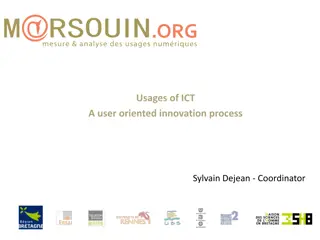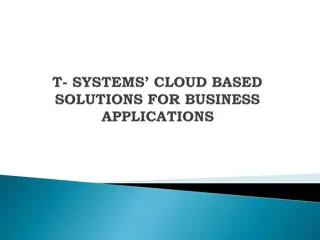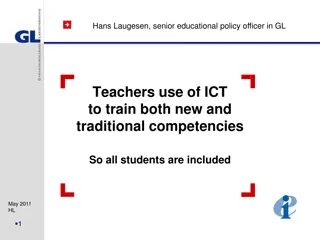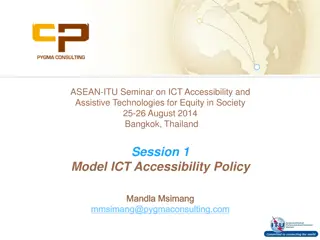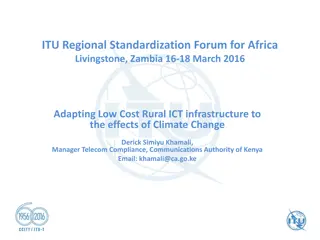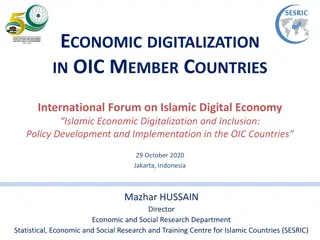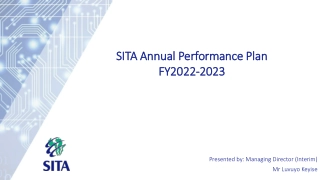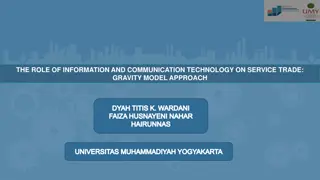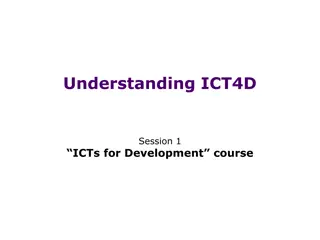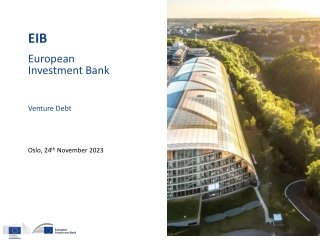The Impact of ICT Investment on Job Creation and Economic Growth
Investment in ICT plays a significant role in job creation and economic growth by contributing to the production of goods and services, increasing productivity, and generating overall growth. The use of ICT capital as an input in various sectors leads to spillover effects and drives GDP growth. Various reports highlight the positive impact of digitalization on GDP and job creation globally, with emerging markets showing notable growth due to factors like offshoring and population size.
Download Presentation

Please find below an Image/Link to download the presentation.
The content on the website is provided AS IS for your information and personal use only. It may not be sold, licensed, or shared on other websites without obtaining consent from the author. Download presentation by click this link. If you encounter any issues during the download, it is possible that the publisher has removed the file from their server.
E N D
Presentation Transcript
Job creation arising from ICT investment and use David Hughes, Intercai Mondiale ICT = I C Tomorrow 28thOctober 2013 Session 2: The Development of ICT for Job Creation 1
How ICT contributes to the economy Production of ICT goods and services, which directly contributes to the aggregate value added generated in an economy Increase in total factor productivity (TFP) of production in the ICT sector, which contributes to aggregate TFP growth in an economy Use of ICT capital as an input in the production of other goods and services Contribution to economy-wide TFP from increase in productivity in non-ICT producing sectors induced by the production and use of ICT (spillover effects) In the past, this contribution has not been found to be significant Source: The Impact of ICT on Growth in Transition Economies, Marcin Piatkowski, Warsaw 2004 2
ICT investment and use generates growth Impact of broadband on GDP Effect of a 10% increase in service penetration on GDP growth in high and low income economies Range of estimates of the effect of a 10% increase in broadband penetration 1.5 1.6 1.6 1.38 1.38 1.4 1.4 1.21 GDP growth (%) GDP growth (%) 1.1 1.12 1.2 1.2 1 1 0.81 0.77 0.7 0.73 0.8 0.8 0.6 0.6 1.21 0.6 1.1 0.43 0.9 0.4 0.26 0.4 0.6 High 0.2 0.2 0.24 0 Low 0 Fixed telephony Mobile telephony Internet Broadband high income low income Source: Qiang and Rossotto for the World Bank, quoted in Broadband Strategies Handbook, ITU; Based on 2000 2006 data Source: Broadband Strategies Handbook, ITU List of sources of impact of broadband investment: Economic Impact of Broadband Infrastructure and Services - Global Review of Evidence WSIS Lab Team 3
Various sources report that investment in ICT may result in growth of jobs Impact of digitalisation on GDP and jobs, 2011 Jobs created per US$1M in GDP growth GDP impact (US$billion) GDP growth per job created No. jobs created 2,370,241 1,117,753 6,002,265 North America Western Europe Eastern Europe Middle East & North Africa Latin America & Caribbean CIS East Asia & Pacific Africa South Asia World 25.3 31.5 7.0 16.5 27.0 11.8 55.8 8.3 9.4 192.6 167,650 213,578 159,015 377,772 636,737 340,820 6.63 6.78 22.72 22.90 23.58 28.88 42.48 74.54 118.91 31.16 150,910 147,487 44,021 43,677 42,404 34,622 23,542 13,415 8,410 32,088 618,699 Source: Booz & Co, WEF GITR 2013 Digitalisation: A measure of ubiquitous access to affordable, reliable, fast and usable digital services by a skilled population In North America, this estimation indicates a contribution to GDP growth of 0.1% and to jobs growth of 0.05% The greater jobs growth in emerging markets was considered to be as a result of large populations, offshoring ,and possibly a greater impact on the economy 4
GDP growth from ICT may increase employment, wages and salaries, or it may increase profit USA: Employee compensation as %age of GDP UK: employee compensation as %age of GDP 44% 54% Source: Federal Bank of St Louis Source: The Great Wages Grab, Trades Union Congress, UK GDP (income method) = employee compensation + operating surplus (~profit) + taxes less subsidies on production and imports Employee compensation (wages and salaries, etc) contribute 42% to 56% of GDP GDP growth from ICT may affect employee compensation or operating surplus An increase in employee compensation may result in higher salaries or higher employment or both There is no clear relationship between ICT production, investment and use, and growth in employment 5
ICT investment and use results in job losses and job gains Impact of broadband investment and use, EU27, 2006 Jobs lost, 000 / year, EU27 Jobs gained, 000 / year, EU27 Productivity improvement in the business services sector Displacement (outsourcing) -103 435 549 -491 Productivity improvement in other sectors -725 New activity in the business services sector 440 New activity in other sectors Displacement (outsourcing) -1,319,000 jobs/year +1,424,000 jobs/year, net 105,000 jobs / year = 0.06% increase in workforce Source: The Impact of Broadband on Growth and Productivity conducted on behalf of the European Commission by Micus Management Consulting GmbH Jobs lost through productivity improvements including through outsourcing Net gain in jobs through new business activities Overall annual employment gain of 0.05% and GDP gain of 0.71% (82.4Bn Euros) GDP growth is higher in advanced knowledge societies in Europe and lower in less developed economies 6
ICT contribution to GDP, labour productivity and employment Impact of ICT investment and use, EU15, USA, transition countries, 1995 - 2001 EU15 2.42 0.46 0.27 0.73 30% USA 3.52 0.82 0.44 1.26 36% Bulgaria 0.51 0.45 0 0.45 88% Czech Rep Hungary 2.27 0.73 0.13 0.86 38% Poland 4.81 0.55 0.14 0.69 14% Romania 0.79 0.22 0 0.22 28% Russia 1.12 0.09 0 0.09 8% Slovakia 4.1 0.55 0.09 0.64 16% Slovenia 4.1 0.54 GDP growth ICT capital contribution ICT sector contribution to TFP Total ICT contribution ICT contribution as %age of GDP growth 3.64 0.71 0.58 1.29 35% 0.54 13% Growth in GDP per person employed ICT capital contribution ICT sector contribution to TFP Total ICT contribution ICT contribution as %age 1.13 0.41 0.27 0.68 60% 2.21 0.74 0.44 1.18 53% 1.91 0.49 0 0.49 26% 2.8 0.75 0.13 0.88 31% 3.25 0.71 0.58 1.29 40% 4.45 0.58 0.14 0.72 16% 3.55 0.26 0 0.26 7% 1.66 0.13 0 0.13 8% 4.76 0.57 0.09 0.66 14% 3.75 0.54 0 0.54 14% Growth in persons employed Overall growth in employment ICT contribution ICT contribution as %age 1.28 0.05 3.9% 1.28 0.08 6.2% -1.37 -0.04 2.9% -0.52 -0.02 3.8% 0.38 0.00 0.0% 0.34 -0.03 -8.6% -2.67 -0.04 1.5% -0.53 -0.04 7.5% -0.63 -0.02 3.2% 0.34 0.00 0.0% Source: The Impact of ICT on Growth in Transition Economies, Marcin Piatkowski, Warsaw 2004; Source of growth in persons employed: Intercai, based on Piatkowski TFP = Total Factor Productivity ICT contributed to GDP growth in all economies, but increased productivity most in the most developed economies ICT increased employment only in the most developed economies ICT increased employment by a small amount in comparison with GDP growth 7
ICT producing and using sectors contribution to GDP growth Contribution of ICT producing and using sectors to GDP growth, EU15, 1995 -2001 Contribution of ICT producing and using sectors to GDP growth, USA, 1995 -2001 ICT producing sector ICT producing sector 19% 24% 27% 45% ICT using industries ICT using industries 35% 49% Non ICT using industries Non ICT using industries GDP growth = 3.73% pa GDP growth = 3.73% pa 8
ICT producing and using sectors contribution to increased labour productivity Contribution of ICT producing and using sectors to labour productivity, EU15, 1995 -2001 Contribution of ICT producing and using sectors to labour productivity, USA, 1995 -2001 3% ICT producing sector ICT producing sector 22% 43% 45% ICT using industries ICT using industries 53% 34% Non ICT using industries Non ICT using industries Growth in GDP per person employed = 1.39% pa Growth in GDP per person employed = 2.19% pa 9
Critical factors in stimulating ICT production and use Possibility of deep structural reforms to the economy New Economy Indicators Quality of regulations and law enforcement Infrastructure Trade openness Financial system R&D spending Human capital investment Labour marker flexibility Product market competition Openness to foreign investment Macroeconomic stability Quality of institutions and regulations Trade openness Direct inward foreign investment Macroeconomic stability Vigorous labour and product market competition Human capital investment 10
Regulate to encourage innovation Product market regulation Public ownership itself does not inhibit ICT adoption Overall product market regulation explains 12% of cross-country differences in ICT investment Possible reasons Low barriers to entry create an incentive to invest in ICT to increase productivity and retain market share Product range expansion, service customisation, better customer response Improvement in production efficiency Competition reduces ICT costs thereby promoting diffusion o o o o Source: OECD Economic Studies No43, 2006/2 Product market regulation and productivity convergence 11
Special taxes on telecommunications conflict with ICT development policies Impact on GDP growth of a special tax on broadband Penetration (no tax) Tax rate Price elasticity of demand High estimate Low estimate Penetration (with tax) GDP multiplier Impact on GDP growth 30% 20% -1.2 -0.6 26.4% 22.8% 0.85 -0.61% -0.31% Example: special tax in Jordan levied after a 16% sales tax: Data services: 8% Mobile services: 24% Source: GLOBAL INDUSTRY LEADERS FORUM 2011 Draft Discussion Paper: Taxing telecommunications/ICT services: an overview, ITU 12
Promoting ICT development Make country market attractive to ICT businesses Complementary tax and other policies Regulate to encourage innovation Eservices enabling law and regulation Fair and equitable institutions Aggressive management of inefficient markets Don t try to protect incumbents entrenched positions Government stimulation of ICT markets egovernment Use the ICT sector s commercial products and services Lead from the front research, best practice implementations, impact assessment Publicise results Promote coordination of the ICT sectors Coordinate availability of investment capital Education 13
Conclusions ICT investment and use results in growth in GDP and increased labour productivity Job growth arises directly and indirectly as a result of investment in ICT Net growth in jobs in the medium term varies Jobs are lost as a result of improvements in labour productivity Jobs are gained as a result of improved competitiveness and from innovation ICT investment therefore changes the competitive positioning of nations and regions resulting in job migration ICT policy implementation models use a wide variety of instruments that help in the development of ICT sectors and resultant jobs growth Tax and regulatory instruments must be included in these implementation models to ensure that they do not act as inhibitors to ICT investment and innovation 14



